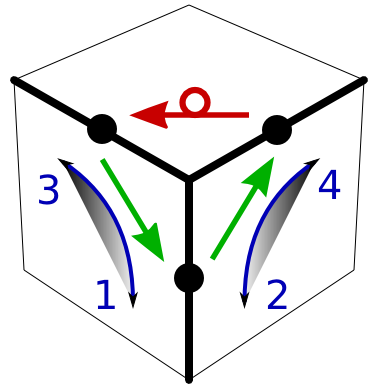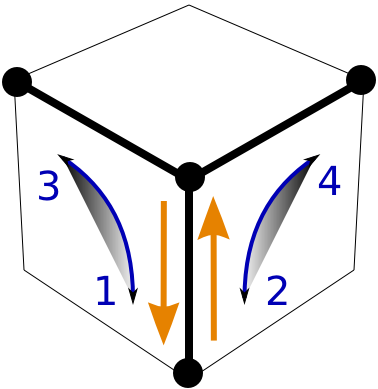A Beginner's Method
to Solve The Cube
Basics
Solving the Cube
- Step 1: Bottom Edges
- Step 2: Bottom Corners
- Step 3: Middle Edges
- Step 4: Top Edges
- Step 5: Solve Edges
- Step 6: Position Corners
- Step 7: Solve Corners
- Done
Extras
Step 3: Solve Middle Edges Except One
| Solve three of the four edges in the middle layer. We don't solve the edge above the unsolved corner. After step 3 we have solved the bottom and the middle layer except for two cubies in a vertical column. |
|
Basic idea
Use the Y-move to cycle edge cubies from the top layer into the middle layer. In preparation of the Y-move, turn D to move the remaining free bottom corner into the corner position that is affected by the Y-move. Undo the D-move when done.
Details
- The edge cubie is in the top layer.
Focus on an edge cubie in the U-layer without a yellow sticker, say the green-red edge cubie. Do a U-turn so that either the green or red facelet match the face of the cube. Then there are two cases:
We prepare with Di so that the Y-moves only involve the free bottom cubie, and we restore the bottom with D. Pick Y or Yi so that the first quarter move 'does the right thing'.Use Di Y D.
Use Di Yi D.
- The edge cubie is in the middle layer.
It doesn't really matter whether we use Y or Yi here, but one of them may give a shorter continuation.Use D Y Di to move the edge cubie to the top layer.
Continue as in 1.
Comments
The basic Y-move is just what we need - but don't forget to prepare/reset the bottom layer.
Alternatives
For simplicity we only use the Y-move in the standard orientation, which starts 'down the front-right edge'. It is worth practicing the Y-move 'side-ways', because we will need it later, and because we may save a quarter turn at the end of the Y-move. Here are two examples:
Y along up-right, R Ui Ri U, |
Y along up-left, then |
Notice that the one-turn savings requires a flip in the starting position compared to case 1 above. Do you see how the last example can be reduced to six turns? (Counting U2 as one move, compare alternatives for step 2.)

